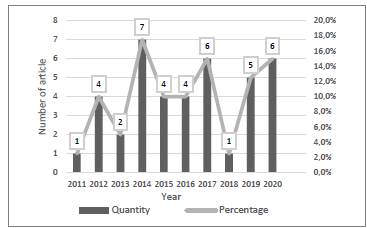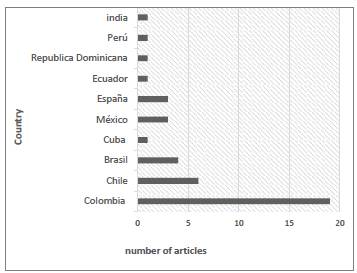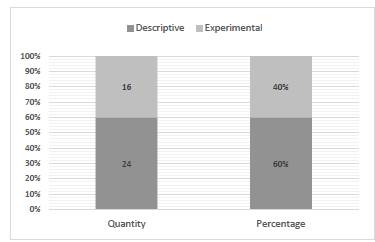1. Introduction
The occupational hazards and risks that health professionals face during their work are diverse, as well as the consequences of them. [1] In recent years, companies in the service sector that attend to people have developed a great demand and, at the same time, have generated health risks for their employees. [2] On the other hand, [3] indicates that the implementation of occupational risk prevention programs in SMEs of the health sector in the Dominican Republic lacks updated legislation promoted by the Ministry of Labor. Furthermore, the approach to social responsibility in health SMEs in the Southwest of Bogota is based on defining an instrument that strengthens the management of socially responsible practices in relation to occupational risks[4]. According to [5], Director-General of the WHO, emphasizes that no country, hospital or health center can safeguard its patients if it does not provide for the safety of its workers in optimal conditions firstly, considering remuneration, respect and training in different areas. In any public or private institution there are different occupational risks; therefore, undesirable events occur, which may result in damage to the health of workers. These variables are usually called risk factors [6]. Within the work environment of health personnel, there are factors that generate an overload. These types of alterations are repeated, given the conditions and risks to which they are exposed [7]. But what factors cause overload in a health care institution? The loss of job security, lack of supplies for the provision of services, staff absenteeism, among others, are factors that produce work overload, fatigue, and physical and mental exhaustion in this group of workers [8].
Likewise, it is pointed out that health professionals are prone to suffer different types of risks. Among the factors, the difficulty in adapting to the use of personal protective equipment, incompatibility of equipment, work overload, inadequate physical structure, absence or inaccessibility of equipment and lack of knowledge of occupational hazards are emphasized [9]. In addition, in order to prevent the consequences, it is important to evaluate, control and improve the conditions in which they live and develop [10].
The general system of occupational risks is related to risk prevention, together with administrative aspects and internal process management based on standards that have become an important sign of evolution, focusing the way organizations act [11]. According to the abovementioned, it is important to bet on a security system within the labor framework. This would improve the internal and external image of the organization [12]. Therefore, the objective is to learn about scientific studies on occupational hazards and safety standards used in healthcare SMEs in the last 10 years.
2. Methodology
2.1. Type of study
A systematic review of the scientific literature was carried out based on the PRISMA method [13], which provides a moie detailed explanation of the methodology. The questions established to initiate the methodological process were as follows:
What are the types of risks for healthcare workers?
What tools allow the identification of psychosocial risks in the healthcare worker?
What have been the safety standards present in healthcare SMEs in the last 10 years?
What conditions ensure the good WSH management?
What type of methodological approach and design have been applied?
What are the benefits of implementing safety standards in the healthcare service?
2.2. Research collection process
To deepen the information search and ensure the results, the following descriptors were used: "Standards management", "safety standards", "occupational risk", "working conditions", "healthcare service", "health sector", "healthcare workers" and "SMEs". To detail the results, search combinations were designed with the terms and Boolean operators: [("Standards management" OR "Safety standards") AND ("Occupational risk" OR "Working conditions") AND ("Healthcare service" OR "Health sector" OR "Healthcare workers") AND ("SMEs")].
2.3. Inclusion and exclusion criteria
Articles published in scientific databases in Spanish, English and Portuguese were included, in order to have a greater informative scope. The year of publication was considered from 2011 to 2021. It is worth mentioning that the search was conducted from March to June 2021. In the ProQuest database, scientific journals were considered as the type of source; in EBSCO, journals and academic publications; in ScienceDirect, Research articles as shown on Fig. 1. descriptive and experimental studies were included in order to have studies that evaluate and apply at least one of the variables of this research as a reference.
Theses, dissertations, books and case reports were considered as exclusion criteria. On the other hand, journals and scientific articles that did not respond to the research questions and that presented information outside the guidelines of the established variables were also excluded. The protocol for the search and separation of information sources was worked on by two reviewers independently, whose differences were tested and analyzed on a reciprocal basis.
3. Results
Through the search for articles, 40 studies were selected for the presentation of results. Regarding the database used, the largest number was from EBSCO (50%), followed by ProQuest (42.5%), and, with a lower percentage, ScienceDirect (7.5%).
3.1. Articles by year of publication
Fig. 2 shows that the largest number of articles were selected from the year 2014, representing 17.5%, followed by articles from 2020, with 15%. In addition, it is observed that the same number of articles were selected from the years 2012, 2015 and 2016, with 5 articles each, representing 10%; with a smaller amount in the years 2018 and 2011, with 1 article each, representing 2.5% of the total.
3.2. Sources by place of origin
In Fig. 3, the largest number of articles comes from Colombia (47.5%), followed by Chile (15%). The Dominican Republic, Cuba, Ecuador, India and Peru have the lowest percentage, with one article each (2.5%).
3.3. Type of study
In relation to the type of study, as shown in Table 1, we have the following: 24 out of the total of 40 articles are descriptive (60%) and a smaller number are experimental (40%). This type of publication will allow us to observe the analytical results of case studies related to the variables chosen, see Fig. 4.
3.4. Approach of variables
A greater predominance is shown with the occupational risks variable (65%) and, in the case of the management of safety standards, there are 14 articles (35%), which shows that there is a greater variety of studies in relation to the risks of the chosen sector, see Fig. 5.
3.5. Research approach
In this unit of analysis, the result is shown in relation to the number of articles for each type of question. This made it possible to answer the questions posed. Table 2 shows the detail.
P1: The types of risks present in health workers can be classified in conditions of the environment; task or conditions of the organization, generated by the effect of positions adopted, loads and pace of work; chemical, physical and biological agents that are specific to their context. Within this point, there are some caused by antineoplastic agents in the work environment, among others. However, those attributable to psychosocial factors that generate a negative impact due to increased stress, aggravating medical conditions of chronic diseases, stand out.
P2: The tools used to identify psychosocial risks are: Maslach Burnout Inventory - Human Services Survey (MBI-HSS) which evaluates the level of job burnout; questionnaires of intralaboral psychosocial risk factors, such as SUSESO-ISTAS 21, which assesses psychosocial risks (it consists of 20 items that are grouped into five dimensions and has been adapted and standardized for Chile); ESCAM, a reliable tool to assess the perception of mental workload; the NSS scale, which analyzes workload focused on the physical environment in nursing.
P3: The safety standards used have been: OHSAS 18001, focused on improving administrative performance against occupational risk prevention, although its application in improving working conditions has not been sufficient; ISO 45001 standard, which helps to generate a safe working environment for employees, controlling factors that may cause injuries, illnesses and deaths; ISO 35001 standard, which allows to control and manage biosafety risks (it is one of the first standards of the biological risk management system for laboratories and other related organizations).
P4: The conditions that support good occupational health and safety management are important to expand knowledge, work on the generation of documents related to biosafety, standardize practices and operations that allow the prevention of different risks. It is also important to consider the aspects identified as factors of organizational influence, supervision and organizational climate.
P5: An approach on service quality standards has been applied, as it includes patient and worker safety following high standards in the medical care needed. As a methodological approach, we have used those that allow the evaluation of working conditions, such as LEST, Renault, Fagor, EWA and Pymes Method of the Mutuas association of Spain.
P6: The benefits of implementing standards correspond to well-defined and documented procedures that support the linkage of results, perennial monitoring of processes and effects, adequate recording of events. In short, it seeks to merge the organization from its policies, as well as its operations and procedures.
4. Discussion
In the systematic review, it is evident that, by training and focusing educational actions on employees, changes in perception are achieved in the face of risks, resulting in a responsible behavior of workers in favor of the organization [25,26,35]. According to the ILO (International Labour Organization), changes must be made by both the workers and the company, who are obliged to take measures to prevent occupational risks [6,23,33]. These risks can be biological, chemical, physical, ergonomic and psychosocial [1,2,9,15,17,19,31], results that are consistent with [20,29,41], where psychosocial risks are highlighted [7,16].
Therefore, the importance of using methodologies and strategies to improve working conditions is emphasized. Among the instruments used, we find: MBI and its different versions, and CESQT [8,10,14,18]. In addition, the use of risk measurement instruments is recommended [24,27,30,32,38]. Likewise, the review points out that a Management of Safety Standards in the health sector provides benefits such as the certification of international standards, welfare and development, increased productivity, and reduction of accident rates [4,21,22,37,39,40]. Thus, it can be applied to any institution or SME [11,28,34,36].
Likewise, studies indicate that, in order to achieve good safety management in SMEs, it is necessary to opt for the application of safety standards [3,11,24]. On the other hand, it is considered that the adaptation or application of standards in health sector requires a more significant use of time, resources and costs [41]. In addition, it is important to specify that there is a flagship production of scientific publications on OSH with themes such as psychosocial risk that may be associated with the clinical approach of the disciplines of the professionals who intervene in these areas. [43,44].
5. Conclusion
In comparison to all the risks present for healthcare workers, priority should be given to psychosocial risk factors, which bring with them other types of risks that trigger more serious conditions to the good condition of physical, mental and social integrity. For this reason, the level of burnout, perception of the mental workload, among others, must be evaluated. It is also necessary that protection mechanisms are given by establishing an internal procedure, where each institution must set its designs, risk maps and hazards, in addition to having a constant inspection, and running periodic analysis according to the established parameters. Likewise, it is recommended to work under a health-based approach before any accident may occur to professionals in this sector. For this reason, it is important to continue expanding studies focused on the scope of the application of safety standards in health institutions. On the other hand, although this review includes the years 2020 and 2021, the systematized information is based on information prior to the pandemic, so that the conditions regarding occupational risks may change considerably in the future.






















